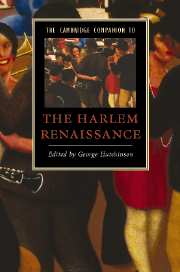16 - “The Aftermath”: the reputation of the Harlem Renaissance twenty years later
from Part III: - The Post-Renaissance
Published online by Cambridge University Press: 28 July 2007
Summary
In 1945 the editors of the Atlanta University journal Phylon wrote to a sixty-five-year-old Carl Van Vechten and asked for his comments on a Hugh Gloster essay they were publishing. Gloster's “The Van Vechten Vogue” sketched out the influence of the best-known white American - half architect, half voyeur - connected to the explosion of black writing in the 1920s. Phylon's editors, the sharp-minded young sociologist Ira de a Reid and the illustrious W.E. B. Du Bois, printed Van Vechten's brief comment. According to the man who had been the leading light of the “Negrotarians,” the white cultivators and supporters committed to the exploration of black life in Manhattan in the 1920s, Gloster was so “eminently fair” in his essay that nothing was left to say. The novelist, photographer, and spirited collector of African American letters could not avoid the fact that he was seeing something that he had predicted would end certain varieties of discrimination. “Negroes are kept down because they lack NERVE and initiative,” Van Vechten had written to his friend Langston Hughes in 1942. Gloster showed both qualities, hallmarks of a new generation of writers and critics, a cadre that would rely considerably less on the support of individual patrons like Van Vechten. He was a man whose era had passed and whose most deeply held convictions about racial equality led the way to the vastly reduced scope of his own role.
In his essay, Gloster targeted not even so much Van Vechten singly as the entire movement during which Van Vechten's most famous relationships with Langston Hughes, James Weldon Johnson, Zora Neal Hurston, and Nella Larsen, among many others, had flourished. In an unusually ironic twist of fate, the movement for black artistic development in the United States, always hand-in-glove with the larger movement for racial justice, and the even broader shift for modernist artistic expression, seemed deliberately employing segregationist logic in its historical self-representation.
- Type
- Chapter
- Information
- The Cambridge Companion to the Harlem Renaissance , pp. 239 - 253Publisher: Cambridge University PressPrint publication year: 2007
- 1
- Cited by



